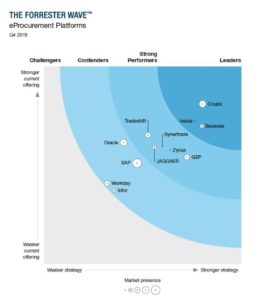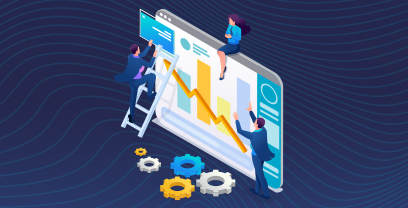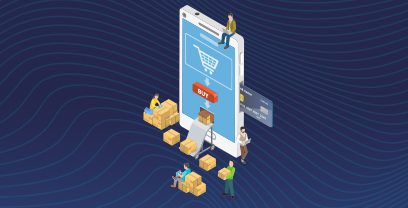|
The Forrester Wave™: Supplier Value Management Platforms, Q3 2024 See Report
Blog »
What is Source to Pay Best Practice? An Analysis by Ivalua
by Alex Saric
This article pulls together several experts on the Source-to-Pay process including Alex Saric of Ivalua and Duncan Jones and Andrew Bartels of Forrester. It makes the case for complete suites over best-of-breed and goes into details as to why ERP vendors are simply struggling to be competitive outside their core areas.
Source-to-Pay Process Best Practice
Last year Forrester published 2 major Wave reports, which together span the full Source-to-Pay process. The first, authored by Duncan Jones and published on December 10, is The Forrester Wave™: eProcurement Platforms, Q4 2019, which covers purchasing and invoicing (similar scope to Gartner’s P2P Suites Magic Quadrant). The second, authored by Andrew Bartels and published on December 18, is The Forrester Wave™: Source-To-Contract Suites, Q4 2019. It covers spend analysis, sourcing, contract management and supplier risk and performance management (SRPM), similar in scope to Gartner’s Strategic Sourcing Application Suites Magic Quadrant. Forrester more recently updated their focused report on SRPM, with The Forrester Wave™: SRPM Platforms, Q3 2020, which provides more in depth analysis of that specific area.
The publication of a new Forrester Wave report (or Gartner Magic Quadrant for that matter) generates a lot of excitement to those of us in the industry. Practitioners regularly refer to them to determine which vendors to invite to RFx’s and, to some extent, which vendor to select. Well aware of the consequences, us vendors anxiously await the results, sweating over whether our dot is positioned in the coveted Leaders band or quadrant. Being relegated to the dustbin, the Contenders band by Forrester (Niche Players quadrant by Gartner), can bring even the burliest technology marketer or sales professional to tears. Fun stuff.
While the focus with these reports is squarely on which vendors are positioned where in the charts, the analyst synopsis of the technology sector and vendor analyses receive relatively little attention, yet provide as much if not more insight. In reading these reports, as well as Gartner’s latest Magic Quadrants for P2P Suites and SSAS Suites, a few significant takeaways stick out.

Lesson 1: Suites reign.
Arguably the biggest debate in the spend management technology industry for the past decade has been that between best-of-breed solutions and complete suites. Specifically, are organizations better off selecting the best technology for each step of their process (SRPM, Sourcing, e Invoicing…) or selecting a complete suite. Theoretically, the trade-off is whether it is better to have the most robust, relevant capabilities in each process or the benefits of a seamless experience, greater automation and better information flow promised by suites. While some still argue the point and there is some commentary in the S2C Wave about niche solutions being pulled in when non-procurement stakeholders are involved, the overall message is clear – suites have prevailed.
The fact that both Gartner and Forrester now publish suite level reports is one proof point. But the report synopsis’ also support this. As Andrew Bartels writes in the Source-to-Contract Wave report,
“CPOs want a suite of software that allows their teams (working with business) to be able to run a sourcing event in the morning, work on a supplier contract at midday, talk with an existing supplier on how to improve its performance in the early afternoon, and identify a new sourcing opportunity at the end of the day, all using the same software interface and with data and work objects flowing from application to application. This CPO demand has pushed vendors that may have offered point solutions for sourcing, Contract Lifecycle Management, spend analytics, or SRPM to expand their portfolio to include all four products.”
While the Covid-19 crisis has caused some firms to start with more focused projects to address urgent needs, suites are still essential as scope increases over time to digitize more processes, ensuring quality data, seamless flow of and access to information and a consistent user and supplier experience. Modular suites enable both a quick start and greater long term value.
Procurement leaders today see the value of suites and the market has responded.
Lesson 2: The Winner Takes it All.
Historically, vendors had distinct strengths, with the leader quadrant or band of analyst reports looking very different from one solution to another, and across analysts. How times have changed. A quick look across the current Forrester and Gartner reports shows the market being increasingly dominated by a handful of vendors with the rest far behind. This is most pronounced in the Gartner reports, where Ivalua, SAP Ariba, GEP and Jaggaer appear as leaders in both the P2P and SSAS Magic Quadrants. In each report, only one other vendor is positioned as a leader in each report. In the Forrester reports, Ivalua and Coupa appear as leaders in the SRPM, S2C and e procurement Wave reports. (While admittedly self serving, I will note here that Ivalua is the only vendor positioned as a leader in all 5 reports.)
A couple factors are at play here. First, the recent spate of acquisitions has led to many of the strong niche providers being consumed by larger vendors, thereby helping the acquirer’s position and eliminating a niche provider from appearing on a specific report. More broadly, vendors have been investing heavily to ensure they are strong in all areas. Those that have succeeded are quickly gaining share, while the others losing it. There are certainly interesting newcomers eager to disrupt the market, but those that show promise seem to be gobbled up before they can achieve any real disruption.
Lesson 3: Integration Comes from Unexpected Places
Ease and level of integration is an important criteria for spend management solutions. That applies both within the source-to-pay process and with back end systems, most notably ERP financials. Integration Source-to-Pay processes matters because it improves automation (ex. it’s hard to have touchless invoicing if there isn’t seamless matching of an invoice to a PO and that PO to the contract) and also decision-making. For example, if a separate supplier record is maintained in various steps of the process, you can’t generate a true supplier 360 for holistic supplier analysis. As AI applications evolve and are increasingly embedded in Source-to-Pay suites, quality data is critical to generating and presenting actionable insights.
As a result, procurement leaders naturally consider integration capabilities when selecting their providers. The default assumption is that solutions from ERP providers have a leg-up on their independent rivals when integrating to that ERP. But reading the vendor descriptions in analyst reports reveals quite the opposite to be true. Gartner’s Procure-to-Pay Magic Quadrant notes that “[d]espite being owned by SAP for several years, SAP Ariba and SAP Fieldglass integration into SAP remains an issue. SAP Ariba and SAP Fieldglass are separate solutions and on different architectures to SAP’s ERP suites. SAP received one of the lowest scores from reference customers in this Magic Quadrant for integration with ERP/financial systems.” Forrester’s S2C Wave notes in its description of Oracle that “[d]espite being built on a single code base, clients said, “[i]ntegration between the apps was horrible, though it has gotten better, and integration with other apps continues to be a problem.” And that is integration with their own backend! The situation is far worse when involving integration to other or multiple ERPs. Independent providers, since they must work with all ERPs, seem to have cracked the integration nut better than in house solutions.
Similarly, it seems intuitive that suites developed in house rather than acquisition would offer seamless integration throughout the S2P process. It is true that suites built by acquisition struggle to offer true integration, which involves the interface, workflows AND at the data model level. They tend to focus on the user experience first (so sales can show a slick demo that conceals limitations) but struggle to achieve deeper levels of integration. In the S2C Wave, Forrester notes that “[w]e view Coupa’s assembly of products on different code bases as suboptimal compared to the organic suites of its leading competitors.” It makes various comments on the stages of integration of acquisitions by various vendors.
But being developed in house is no guarantee of seamless integration. The Forrester S2C Wave points out that “Ariba’s suite is a collection of capabilities, but not fully integrated or seamless. User experience is not consistent across the suite.” For Zycus, it notes that “its practice of having separate development teams for each product has created issues of missing integration points between the modules.”
The bottom line when it comes to integration is clear – it can’t be taken for granted and must be carefully assessed. Check your premises.
Lesson 4: ERPs Lag.
Duncan Jones of Forrester has previously spoken about his view of the future IT universe as being one of intelligent platforms and their ecosystems. He seems to view the ERP hegemon approach as having failed, resulting in today’s fragmented reality, with multiple instances, point solutions, and manual workarounds. He has spoken of the future of IT environments at enterprises as consisting of several, focused platforms, integrating with each other where relevant and being connected to a broad ecosystem. A single platform for customers, one for financials, one for suppliers, etc. For the supplier platform, that ecosystem would presumably include suppliers, 3rd party information sources, banks, etc.
In looking at the 3 Forrester Wave reports, the vendor positions seem to bear this out. The ERPs are simply struggling to be competitive outside their core areas. Regardless of whether they developed their solutions in house (Oracle, partially for Workday and Infor) or via acquisition (SAP, Workday with its recent Scout RFP acquisition), the result is the same. In the eProcurement Wave, the worst band (Contender) of vendors consisted entirely and exclusively of ERP players (SAP Ariba, Oracle, Infor, Workday). The report notes that Ariba had been a leader since 2007 but that “SAP Ariba’s outdated architecture, combined with years of inconsistent leadership and excessive churn within product management, has taken its toll.” The only ERPs to even feature in the S2C Wave are Oracle (again in the worst band) and SAP Ariba, who did break into the crowded leader band but in the worst position of the 5 leaders and with many cautions in its description. No ERPs appear as a Leader in the new SRPM Wave. It seems focus is truly needed to deliver the innovation and customer-centricity expected in this competitive space.
In summary, if you haven’t yet read the full analyst reports, I encourage you to do so. The charts are fun (and great marketing for vendors that are positioned as leaders), but there are much deeper insights that stick out from the details.

Alex Saric
Chief Marketing Officer
Alex has spent over 15 years of his career evangelizing Spend Management, shaping its evolution and working closely with hundreds of customers to support their Digital Transformation journeys. As CMO at Ivalua, Alex leads overall marketing strategy and thought leadership programs. Alex also spent 12 years at Ariba, first building and running the spend analytics business as General Manager. He then built and led Ariba’s international marketing team until successful acquisition by SAP, transitioning to lead business network marketing globally. Earlier, Alex was a founding member of Zeborg (acquired by Emptoris)where he developed vertical Procurement applications. He began his career in the U.S. Cavalry, leading tank and scout platoons through 2 combat deployments. Alex holds a B.S. in Economics from the U.S. Military Academy at West Point and an international M.B.A. from INSEAD.
You can connect with Alex on Linkedin


